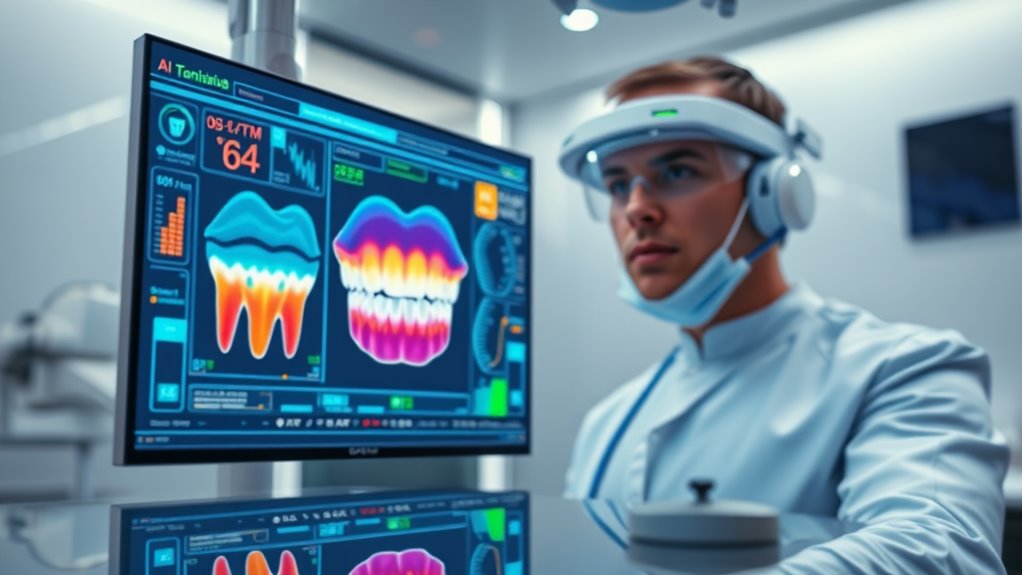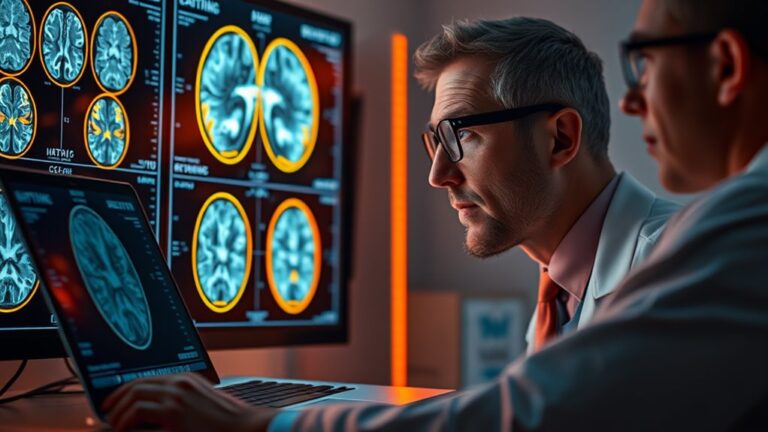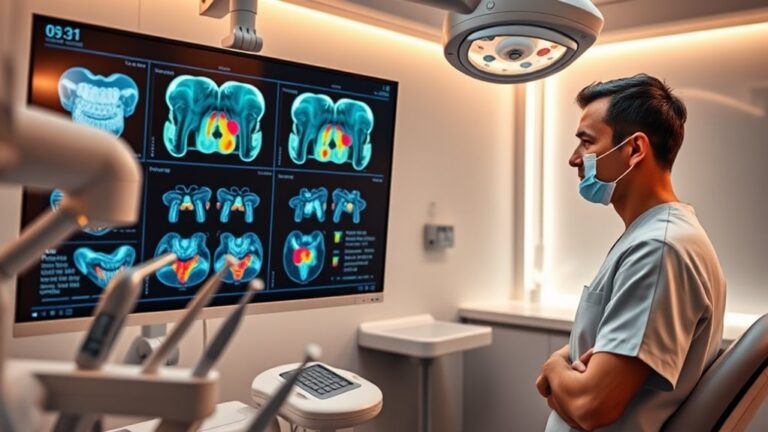AI-Driven Diagnostics: Revolutionizing Oral Health Insights
You might not realize just how much AI-driven diagnostics are changing the landscape of oral health. With advanced imaging techniques, these systems enhance accuracy in detecting dental issues, allowing you to catch problems earlier than ever. They also streamline treatment planning, tailoring solutions to individual needs and improving overall patient care. As this technology evolves, several questions arise about its implications and challenges. What does the future hold for AI in dentistry, and how will it shape your experiences with oral health care? If you have questions or need assistance with AI-driven dental solutions, feel free to contact us. We can connect you with experts who can provide valuable insights and solutions tailored to your needs.
AI-Powered Imaging Techniques
Harnessing AI-powered imaging techniques is revolutionizing the field of oral health diagnostics. By employing advanced AI algorithms trained on extensive datasets of dental radiographs, you can now recognize subtle patterns and variations with remarkable accuracy. These deep learning techniques enable rapid analysis of radiographic images, automating the diagnostic process and substantially reducing human error.
The integration of image augmentation enhances your ability to identify abnormalities such as cavities, gum disease, and impacted teeth. AI algorithms apply color gradients to radiographs, highlighting areas of concern—cavities appear in red, while periodontal disease shows up in yellow. This visual aid directs your attention to specific conditions that require closer inspection, facilitating quicker and more accurate diagnoses. Additionally, AI enhances diagnostic accuracy through swift identification of issues, enabling practitioners to make informed decisions more rapidly.
Moreover, AI's capability to detect and classify dental implants streamlines assessment processes. By accurately localizing implants amidst complex anatomical structures, it differentiates them from surrounding tissues, minimizing the risk of complications.
The use of AI in processing radiographic, cone-beam computed tomography (CBCT), and intraoral scan data fosters precision in diagnosing and treatment planning, ultimately enhancing patient care in oral health.
Personalized Treatment Planning
The advancements in AI-powered imaging techniques set the foundation for developing personalized treatment planning in oral health. By analyzing vast amounts of patient data—including genetic profiling, medical history, and lifestyle—AI uncovers patterns and trends that may elude human researchers. This thorough analysis allows for treatment customization tailored to each patient's unique circumstances.
AI-driven systems integrate diverse data sources, creating detailed patient profiles that inform treatment strategies. They consider factors such as age, bone quality, and prior treatment experiences, ensuring that the recommended plans align with your aesthetic and functional preferences. Additionally, AI algorithms can examine dental scans to identify underlying issues early on, further enhancing the personalization of treatment.
In addition, predictive analysis aids in anticipating potential complications, such as implant failure, by identifying risk factors early on. These technologies also simulate comparisons of different treatment options, predicting the best outcomes based on individual anatomy. By providing insights into potential risks and outcomes, AI enhances the precision of treatment plans and encourages preventive measures tailored to your specific needs.
This personalized approach not only optimizes patient care but also fosters a deeper connection between practitioners and patients, ultimately leading to improved satisfaction and health outcomes.
Early Detection Strategies
Early detection strategies in oral health leverage sophisticated AI algorithms to enhance diagnostic accuracy and facilitate timely interventions. These technologies play a vital role in identifying potential risks and predicting diseases before they escalate, ultimately improving patient outcomes.
By utilizing AI-driven imaging and analysis, you can embrace the following benefits:
- Precision: AI systems detect conditions like cavities and gingival inflammation with sensitivity and specificity exceeding 90%, reducing the likelihood of missed diagnoses.
- Proactivity: Early identification of disease indicators allows for timely interventions, transforming the management of oral health from reactive to preventive.
- Empowerment: AI tools can inform you about risk factors, aiding in personalized care plans that foster healthier habits and improve overall oral health. Additionally, AI enhances accuracy in diagnostics, allowing for the early detection of potential issues.
Implementing AI in dental practices enhances risk assessment and disease prediction, allowing for noninvasive screening and targeted interventions.
As you integrate these technologies into your practice, you'll not only elevate diagnostic accuracy but also contribute to a paradigm shift in how oral health issues are approached, ensuring better health for the communities you serve.
Enhancing Patient Management
Integrating AI-driven diagnostics not only enhances early detection of oral health issues but also substantially improves patient management. With streamlined scheduling, you're able to optimize patient appointments effectively. AI tools manage schedules, reducing missed appointments through automated reminders that guarantee patients remember their visits. This efficiency not only heightens patient satisfaction but also alleviates the administrative burden on your staff.
Automated follow-ups play a vital role in enhancing patient compliance. AI systems analyze individual patient data, identifying patterns that allow you to implement proactive interventions. Personalized treatment plans foster adherence, as patients feel more engaged and informed about their care. Additionally, AI's capability for predictive analytics enables you to foresee potential challenges in patient adherence before they arise.
By utilizing AI-driven communication, you can provide tailored recommendations and explanations, which further enhances understanding of treatment plans. Moreover, AI can predict patient behaviors, allowing for timely adjustments to these plans. This predictive capability guarantees that care remains relevant and effective.
The combination of these technologies leads to improved administrative efficiency, freeing up your staff to focus more on patient care rather than paperwork. Ultimately, AI-driven diagnostics not only revolutionize your practice but also create a more supportive and engaged environment for your patients.
AI in Oral Health Education
As advancements in artificial intelligence redefine educational landscapes, AI in oral health education emerges as a transformative force. Through AI simulations, dental students can hone their skills in risk-free environments, guaranteeing they're well-prepared for real-world scenarios. These innovations foster personalized learning pathways, catering to individual needs and enhancing engagement.
1. Empowered Learning
Students experience tailored feedback and resources, fostering a deeper understanding of complex procedures. This approach mirrors the impact of AI-driven algorithms in diagnosing oral diseases, enhancing the learning experience through real-world applications.
2. Enhanced Skills Development
With immersive simulations, you can improve diagnostic and clinical decision-making skills, directly benefiting patient care.
3. Continuous Education
Access to up-to-date information guarantees dental professionals remain at the forefront of oral health advancements.
The integration of AI into oral health education not only enhances curriculum development but also emphasizes experiential learning. It's crucial that educators and learners embrace the defined core curriculum on oral and dental AI, guaranteeing a thorough understanding of AI principles and applications.
Future Innovations in AI
The landscape of oral health is on the brink of transformation, driven by future innovations in AI that promise to refine diagnostics and treatment methodologies. With enhanced accuracy in diagnostic tools, AI can detect issues like cavities and gum disease with remarkable precision.
Early detection capabilities empower you to intervene before conditions worsen, while predictive modeling enables the development of personalized treatment strategies tailored to individual patient needs. As staff shortages become more prevalent in healthcare, the integration of AI can help alleviate some of the burden on dental professionals.
As you embrace these advancements, AI ethics and regulatory frameworks will play a vital role in ensuring these technologies are utilized responsibly. Transparent AI models will guide clinicians, providing them with clear data and reasoning behind recommendations, fostering trust in AI-driven decisions.
Future innovations may also include AI-powered robots assisting in procedures, optimizing precision and efficiency in dental care. The integration of data from various domains will provide an extensive view of patient health, ultimately improving outcomes and reducing hospital readmissions.
In this evolving landscape, your commitment to ethical practices and adherence to regulatory standards will be essential in harnessing AI's full potential, ensuring that these innovations serve the best interests of patients and the broader community.
Challenges in AI Integration
AI integration into dentistry faces several formidable challenges that can hinder its effective implementation. Overcoming these obstacles is essential for enhancing patient care while guaranteeing ethical practices.
1. Data Privacy
The sensitive nature of health information necessitates stringent data protection measures. Any breach can erode patient trust and compromise your practice's integrity.
2. Regulatory Compliance
As regulations evolve, staying updated on guidelines is vital to mitigate risks associated with bias and data privacy violations. This includes adhering to standards like GDPR.
3. Integration Hurdles
Merging diverse data types—such as radiographic and clinical data—poses significant technical challenges. Inconsistent data quality further complicates AI model training and implementation.
These challenges require a concerted effort to guarantee reliable AI predictions and foster a culture of trust and transparency. By addressing these critical areas, you can pave the way for effective AI integration in dentistry, ultimately benefiting patient outcomes and maintaining ethical standards in your practice.
Ethical Considerations in AI
Traversing the ethical landscape of AI in oral health requires a thorough understanding of several core principles that guide its implementation. Central to this is patient autonomy, which mandates transparency and informed consent in AI interactions.
You must guarantee that patients are fully aware of how their data will be utilized, thereby empowering them in their healthcare decisions. Additionally, algorithmic fairness plays a critical role in mitigating biases inherent in AI systems. By incorporating inclusive data practices and diverse programming teams, you can help prevent existing health disparities from being exacerbated. Continuous monitoring of AI systems is essential to maintain fairness and guarantee equitable health outcomes for all patients. Moreover, implementing safeguards for data privacy and security must be a priority. Patients deserve assurance that their sensitive information is protected, and that AI technologies operate within established privacy frameworks.
Furthermore, to ensure compliance with regulations like HIPAA, it is crucial that all AI applications in healthcare prioritize patient privacy and data protection. Lastly, human oversight is essential to augment, rather than replace, clinical judgment. Establishing clear accountability among AI developers, healthcare professionals, and institutions ensures ethical compliance and enhances trust in AI-driven diagnostics.
Your commitment to these ethical principles will ultimately foster a more equitable and effective oral health landscape.
Frequently Asked Questions
How Does AI Improve Patient Communication in Dental Care?
AI improves your communication in dental care through visual aids, patient previews of treatment outcomes, automated reminders for appointments, personalized messages that build trust, enhanced referrals, and virtual consultations that clarify treatment plans effectively.
What Are the Costs Associated With Implementing AI in Dental Practices?
Implementing AI in dental practices is like planting a garden; it requires an initial investment for hardware costs and training expenses, alongside ongoing maintenance and software fees to guarantee flourishing growth and superior patient care.
Can AI Systems Be Used for Patient Education on Oral Health?
Yes, AI systems enhance patient education on oral health through personalized education and visual aids. They tailor materials to individual needs, improving understanding and engagement, thereby facilitating better communication and adherence to treatment protocols.
How Is Patient Data Kept Secure in Ai-Driven Diagnostics?
Imagine a fortress safeguarding patient data; it relies on robust data encryption and strict anonymization protocols. You guarantee only authorized access, maintaining transparency and compliance, while continuously educating patients about their data's security and usage.
What Training Do Dentists Need to Use AI Tools Effectively?
To use AI tools effectively, you'll need strong AI literacy and technical proficiency. Engage in hands-on training and continuous education, focusing on data interpretation and machine learning concepts to enhance your diagnostic capabilities and patient care.
Conclusion
As we embrace AI-driven diagnostics in oral health, let's not forget the irony: machines are getting better at reading our teeth than we are at flossing. While these algorithms revolutionize our understanding and treatment of dental issues, it's almost comical that we rely on technology to catch what our own eyes miss. Perhaps the real innovation lies not just in the technology itself, but in our ability to remember to schedule that long-overdue check-up.
If you find yourself overwhelmed by the complexities of maintaining your oral health, don't hesitate to reach out to us for assistance. Our expert help can save you time, reduce stress, and significantly improve your dental practice. Let us guide you through the nuances of dental care so you can focus on what truly matters—your smile!





